Ashikaga
Ashikaga (足利) is a city in Tochigi prefecture, Japan, near the prefecture's border with Gunma.
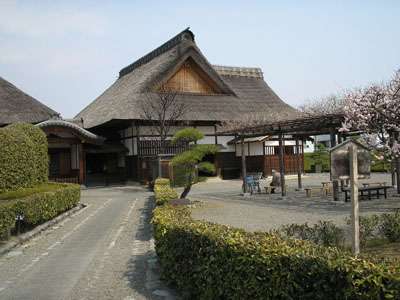
Understand
Ashikaga makes an ideal day trip from Tokyo. It's a small city with a lot of history packed into an attractive and easily walkable radius, from the mound tombs (kofun) and mountain-top shrines of pre-Buddhist Japan to dozens of temples built by members of the long-powerful Ashikaga clan, notable patrons of classical Japanese theatre (Noh), art (flower arranging and tea ceremony), and architecture (the Golden and Silver Pavilions in Kyoto). The Ashikaga clan was an offshoot of the Minamoto clan who conquered Honshu and dominated the Kamakura Shogunate (1185-1333). Ashikaga Takauji overthrew the Kamakura shoguns and installed himself in the Muromachi district of Kyoto. The Ashikaga shoguns did not just help beautify Kamakura and Kyoto, they also built temples, gardens, and retirement villas in their hometown, which has been called a Little Kyoto and calls Kamakura one of its sister cities. The clan also sponsored the Ashikaga Gakkō, the most famous Confucian academy of eastern Japan, and Ashikaga has a friendship city relationship with Jining (Shandong), China, which includes Qufu, the hometown of Confucius.
As the Ashikaga shoguns got weaker, the country fractured into civil war, until it was reunited and pacified under the Tokugawa Shogunate, with its headquarters in Edo (modern Tokyo). Ashikaga and other towns on the edge of the Kanto plain prospered as Edo grew into a bustling metropolis, two of Ashikaga's specialties being soba and silk. Classic, Edo-period merchant stronghouses are still frequent sights along Ashikaga streets. Long prominent in the silk industry, Ashikaga, Kiryu, and nearby towns became important centers of Japan's industrial revolution, with textile manufacturing leading the way. Although the factories have moved overseas, textile handicrafters are still active, and fine woven goods can be found in many local souvenir shops.
Get in
Travelers coming from Narita airport should note that bus may be cheaper, faster and more convenient than taking train.
By train
The nearest Shinkansen (bullet train) stations are Oyama on the Tōhoku Shinkansen and Takasaki on the Jōetsu Shinkansen, both of which are connected to Ashikaga by the JR Ryōmō Line (両毛線), which has about 30 trains daily running in each direction between about 5AM and 11PM. JR Ashikaga station is on the north bank of the Watarase River, in the older, more walkable section of town. JR Ashikaga Flower Park Station, also on the JR Ryōmō Line, is seven minutes away on foot from Ashikaga Flower Park.
The private Tōbu Asakusa-Isesaki Line (東武伊勢崎線) runs about 60 trains in each direction through Ashikaga-shi station every day between about 5AM and midnight. Express trains leaving Asakusa in Tokyo reach Ashikaga-shi in about 75 minutes (60 minutes from Kita-Senju in Tokyo). The local (or "Section Semi-Express", "Section-Express") takes twice as long. Kita-Senju is more convenient than Asakusa as a transfer point in the Tokyo area. Tōbu Ashikaga-shi station is on the south bank of the Watarase River, in the rapidly expanding south side of town, with strip malls, big-box retailers, and ample parking.
By bus
The Keisei Bus Salvia line runs directly between Narita airport and Ashikaga each way daily for ¥4400 one way. The trip takes about 3 hours, depending on Tokyo traffic. Five buses leave Tōbu Ashikaga-shi station between 4:20AM and 1:20PM, and five buses leave Narita between 8:10AM and 7:25PM.
By car
Take the Sano-Fujioka exit from the Tōhoku Expressway and follow National Route 50 west toward Ashikaga. The four-lane divided highway is usually busy, and highway buses schedule a half-hour between the Sano Premium Outlets and the Ashikaga train stations. National Route 50 runs along the south edge of Ashikaga.
Take the Ashikaga exit from the Kita-Kanto Expressway and follow National Route 293 south toward Central Ashikaga.
It takes 15 minutes from the Ota-Kiryu exit in the Kita-Kanto Expressway to central Ashikaga. Take the Ota-Kiryu exit and follow National Route 122 & 50 east toward Ashikaga.
Get around
The Ashikaga City Bus runs 4 times a day each way through Ashikaga on a long route that runs far up the mountain valleys that flank the city. It costs ¥200 each way.
The old downtown of Ashikaga north of the Watarase River is very walkable, while the riverbank is very bikeable (and walkable). A bicycle trail runs along the levees for the full length of Ashikaga city, sometimes along the north levee, sometimes along the south. The levees were raised and flood control measures were improved after severe flooding in the wake of Typhoon Kathleen in 1947.
See
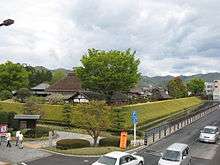
- 🌍 Ashikaga School (足利学校 ashikaga gakkō), Shōhei-cho 2338 (drivers can park directly across Route 293 behind a large souvenir shop; walkers along main street-Tōri, 1-chome-can turn onto the flagstone-ishidatami-entranceway at the Confucius statue), ☎ +81 284-41-2655, fax: +81 284-41-2082. Daily 9AM-4:30PM (4PM October–March). Closed 3rd M October–March, 3rd Tu April–September. Known as Japan's oldest university, Ashikaga School was established during the 1400s by deputy shogun Uesugi Norizane (although some credit Lord Ashikaga Yoshikane during the Kamakura period, and still others claim it dates from either the Nara or the Heian period). In any case, by the 1500s, St. Francis Xavier and other foreign missionaries recognized Ashikaga School as the most famous university in eastern Japan. The school was abolished after the Meiji Restoration and then converted into an elementary school when the site passed into city control in 1902. After a decade of preparatory work, the original grounds of Ashikaga School were beautifully restored in 1990 as a National Historic Site, a designation it received in 1921. The thatched-roof buildings and manicured grounds are well worth seeing. ¥400 per adult.
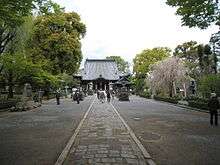
- 🌍 Bannaji Temple (鑁阿寺), Ietomi-cho 2220 (walkers along main street-Tōri, 1-chome-can turn north onto the next flagstone street west of the Confucius statue), ☎ +81 284-41-2627. Daily 10AM-5:30PM. Founded by Ashikaga Yoshikane during the early Kamakura period (1192-1333), Bannaji Temple maintains the style of a samurai residence of that era. It was designated a National Historic Site in 1922. In addition to the main temple, the spacious grounds include a bell tower, library, and other buildings, as well as a fine assortment of trees, including cherry trees and a huge, old gingko tree. Free.
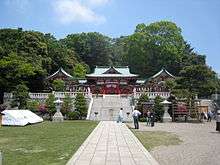
- 🌍 Orihime Shrine (織姫神社), Nishinomiya-cho 3889 (about 20 min on foot from the north gate of JR Ashikaga station). A shrine was built here in 1879 to enshrine the deities Yachichihime no mikoto(八千々姫命) and Amenomihoko no mikoto(天御鉾命), and to protect the textile industry of Ashikaga. In 1880, it was reduced to ashes in a fire and the current shrine building was built in 1937. It stands in the midst of Orihime Park and is also the departure and arrival point for the hiking course in the Ashikaga Prefectural Natural Park.
- 🌍
Ashikaga Flower Park (あしかがフラワーパーク), Hasama-cho 607 (off the road leading to Midori-bashi at the western end of old Ashikaga; walkers can take the JR train one stop east to Tomita, then walk back west along Old Route 50 around a hill and S-curve to a small cluster of shops, then walk eastward down a small road in front of an apartment building, through a small underpass beneath the railway tracks, and into the park's ample parking lot), ☎ +81 284-91-4939. The opening time will change according to the season.. A 20-acre park most famous for its four huge wisteria arbors, in bloom from mid April to mid May, the park contains such a wide variety of flowers and trees that it is worth seeing in any season: plum blossoms in February–March, hydrangeas in June–July, lotus flowers in May–October, purple sage in October–November, and roses in May–June and September–November Lights adorn the trees in midwinter. The western side of old Ashikaga is bounded by the Ashikaga Park hillsides, containing large mound tombs from the pre-Buddhist Kofun Period (roughly AD 300-700). At the park entrance is a large souvenir shop and a beer restaurant open 10AM to 7PM. The admission fee changes according to the season.
- 🌍 Sōun Museum (草雲美術館). On the south edge of the park is the small Sōun Museum, housing landscape and nature paintings by the Ashikaga clan's official artist, Tazaki Sōun (1815-1898), who exhibited his depiction of Mount Fuji at the World's Columbian Exposition in Chicago in 1893. ¥210.
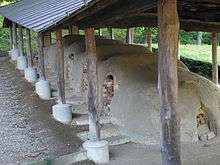
- 🌍 Kurita Museum (栗田美術館), Komaba-cho 1542 (walkers can take the JR train one stop east to Tomita, then walk back west along Old Route 50 and turn right across a railway overpass toward a cluster of black brick and white plaster buildings easily visible and well signposted on a hill), ☎ +81 284-91-1026. Daily except at New Year's 10AM-5PM (6PM on Sundays and holidays). A beautifully landscaped 24-acre park whose carefully designed buildings house one of the finest and largest collections of Imari and Nabeshima porcelain in the world. Other exhibits include historical and archaeological information. There is also a small atelier and a climbing kiln near the base of the hill, and a working (but off-limits) potters' village behind the sprawling complex. The gift shop inside the gates offers ceramics of greater distinction and quality than the huge, A-frame gift shop across the large parking lot. Admission ¥1550 per adult.
Do
- 🌍 Ashikaga Machinaka Yūgakkan (足利まちなか遊学館), Tori 1-chome, 2673-1 (right on main street, on the right corner of the flagstone-paved street leading into Ashikaga Gakko), ☎ +81 284-41-8201. Daily 9AM-5:00; closed 3rd M every month and at year end. This "play-learn" emporium not only exhibits locally made textiles and actual working looms and braiding and threading machines, it also offers weaving lessons on small handlooms. ¥400 per lesson (30-45 minutes).
- Coco Farm and Winery, Tajima-cho 611 (deep in a valley north of Ashikaga; by car take Route 293 north and follow the Coco Farm signs; by taxi from JR Ashikaga, budget ¥2000 each way), ☎ +81 284-42-1194, fax: +81 284-42-2166, e-mail: office-m@cocowine.com. Gift shop open daily 9:30AM to 5:30PM; cafe open daily 11AM to 4PM; winery tours at 11AM, 1PM, 3PM; closed 31 December through 2 January. Founded in 1950 as a boarding school for underachieving kids, it gradually evolved into a self-supporting vineyard, produced its first wine in 1980, established ties with Sonoma vineyards, then hired a California vintner, and provided the sparkling wine for the G7 summit in Okinawa in 2000. Per-glass prices range from ¥300 to ¥1000, with a variety of hors d'oeuvres at a similar range of prices. A sample of three wines and matching hors d'oeuvres can be ordered for ¥2000. Winery tours cost ¥500 per person; five Coco Farms wines can be sampled for ¥500.
- 🌍 Natural Indigo Dyeing Airoza (天然藍染 藍絽座), 2-7-5, Ise-cho (5 minutes walk from JR Ashikaga station of JR Ryomo Line, 5 minutes drive from the Ashikaga exit of the Kita-Kanto Expressway), ☎ +81 90 - 9103 - 5572, e-mail: indigojp@e-mail.jp. 10AM-5PM. You can create your own design natural indigo dyeing cloth within one hour. Choose what you like from Handkerchief (¥1000), Japanese Towel (¥2000), Cotton Stole (¥3000), Tote Bag Small (¥3500), Tote Bag Large (¥4500), T-shirt 100-130cm (¥3500), T-shirt 140cm-XXXL (¥5000). English and Japanese speaking instructor will guide how to make design and dye. Also you can buy natural indigo dyed clothes such as blouses, tunics, shirts, T-shirts, skirts and more. ¥1000.
Buy
The principal local specialties of Ashikaga are: textiles, soba noodles, and now Coco Farm wines and a locally made citrus wine.
The most convenient place to shop for textiles is along the flagstone-paved (ishi-datami) streets that lead into Bannaji and Ashikaga Gakko. Natural indigo dyes are a local specialty, but look for some very nice natural brown dyes from walnut and chestnut as well. The less expensive varieties of each fabric are most likely made in China (and sometimes India).
A range of Coco Farm wines can be found in most supermarkets, but you might need to look in larger specialty liquor stores for the best (and more expensive) varieties, or at Coco Farms itself. Their labels range from the basic Coco Farm (¥1100-1200) and Oak Barrel (¥1200-1500) to the less widely available Coco Ima (¥1500-1800), Aubade (¥5000), and Novo sparkling wine (¥9000) lines.
The most convenient shopping for soba noodles and other edible souvenirs can be found in many shops along main street (Tōri 1-chome to 7-chome), running parallel and north of the JR railway tracks, and Grand Avenue (Gurando Tōri), which runs north directly out of the JR Ashikaga station. The gift shop at the Flower Park also offers a large variety of comestible souvenirs.
Eat
- Cutlet Sankatsu (カツレツ三活), Tōri 4-3489-2 (right at the north end of Watarase Bridge), ☎ +81 284-21-3855. Th-Tu (closed W) 11AM-2:30PM, 5-9PM. Either choose your own samples from a variety of specialty cutlets filled with cheese to nori-wrapped mince to the more traditional slab of pork or chicken, at ¥400 per dish (of two); or order the Watarase set of six for ¥2550 (with rice, soup, pickles). Lunch specials, ¥650-750; cutlet bento, ¥1650.
- Italian Gelateria Romano (ロマノ), Shōhei-cho 2366 (on the flagstone-paved sidestreet connecting the streets entering Ashikaga Gakkō and Bannaji), ☎ +81 284-44-6078, fax: +81 284-44-6079. Tu-Su (closed M) 11AM-6PM. This pleasant shop offers a nice variety of refreshing, intensely flavored gelato, from Italian vanilla and café mocha to black sesame and green tea, served in either cups or fresh-made waffle cones. Single cup or cone ¥350, double ¥500. Junior cup ¥250, junior special ¥300. Crepes ¥350-400.
- Kappō Kaiseki Chō-ya (割烹 会席 蝶や), Tōri 2-2652 (on the north side of main street near the Hotel Ashikaga-kan), ☎ +81 284-41-2456. Th-Tu (closed W) 11:30AM-2PM, 5-10PM. A nice, unpretentious place to indulge in a leisurely Japanese kaiseki (multicourse "tasting menu") dinner, or a fine teishoku (one-tray set-menu) meal. Teishoku ¥1350–2000; kaiseki ¥4500, ¥5500; ¥6500.
- Santa Tori Maruyaki (さん太とり丸焼), Tanaka-cho 920-9 (across the street from the Tōbu Ashikaga-shi station complex), ☎ +81 284-72-1825. Tu-Su (closed M) 5:30-11PM. This izakaya-style restaurant specializes in rotisserie chicken and relatively healthy side dishes. The sage and thyme on the rotisserie chicken was a delightful surprise, and so were the fulsome salads. Japanese-style seating except at the counter. Drinks by the glass include local wine (Coco Farms) and a fine Oyama sake (鳳凰美田 Hōōbiden) for about ¥500. Full chicken ¥1000, half ¥650; quarter ¥400. Other dishes range between ¥500 and ¥1300.
- Southwest Paradise, Shōhei-cho 2360 (on the flagstone-paved sidestreet connecting the streets entering Ashikaga Gakkō and Bannaji), ☎ +81 284-43-3484. Tu-F noon-2PM & 5:30PM-1AM; Sa noon-2AM; Su noon-11PM. A little bit of New Mexico in old Ashikaga. Various pasta or taco dinners ¥1280; drinks about ¥500; snacks about ¥400.
- Teuchi Ramen Maruyama (手打らあめん丸山), Tanaka-cho 957-7 (one block west of Tobu Ashikaga-shi station on Tanaka-dori), ☎ +81 284-71-5254. W-M (closed Tu and 3rd W each month) 11:30AM-2:30PM, 5-8:30PM. This local favorite makes its own high-quality ramen, gyoza, and char siu. A bowl of its highly recommended garlic ramen runs about ¥800.
- Suzu Okonomiyaki (すずお好み焼き), Ise-cho 3-chome, 9-9 (near the far-end, lefthand corner of the third block of Grand Avenue, which runs north from JR Ashikaga station), ☎ +81 284-42-8020. Sa Su noon-9:30PM, Th F M Tu 1-9:30PM. Run by a friendly, well-traveled couple whose souvenirs decorate the small but spotless restaurant. You choose your ingredients and cook okonomiyaki, monja, yakisoba, or other items at teppan tables. Typical menu items range between ¥400 and ¥800.
- Tonkatsu Sakae (とんかつ栄), Ise-cho 2-chome (head one block up Grand Avenue from JR Ashikaga, cross main street, turn right, and stop a few doors down), ☎ +81 284-42-0541. Open F-W (closed Th) 11AM-2:00, 5-9PM. (memory-aid: o-i-shi-i). This busy, family-run local favorite displays the Ashikaga Fine-Dining Club (Umaimono-kai) seal of approval and serves up food that well deserves it. The chicken katsu is all breast meat, no skin, no fat. Their fried oysters are great, too. Set-menu dinners run from ¥950-1900.
- Tori-tsune (鳥つね), Midori-cho 1-3336 (on the street leading to Midori-bashi near Ashikaga Park and the western end of old Ashikaga), ☎ +81 284-21-2202. Th-Tu (closed W) 11:30AM-2PM, 5-8:30PM. This local favorite for 70 years offers a range of specialties, from yakitori sticks at ¥500 to a full unagi (eel) dinner at ¥2700.
- Uoe (うおえ), Igusa-cho (on the back street running parallel to main street, leading from the southwest corner of Bannaji to the lower entrance to Orihime Shrine), ☎ +81 284-22-2200. M-Sa (closed Su) 11:30AM-2:30PM, 5:30-9:30PM. Hosted by a friendly sushi chef who trained in San Francisco and Maui and understands a lot more English than he speaks, this longtime seafood restaurant in fresh new digs features fine fresh fish and regional sake, all presented creatively and deliciously. Lunch specials from ¥800; set-menu dinners from ¥1200; glasses of regional sake range from ¥450 to ¥950.
Drink
- Café de Furukawa, Shōhei-cho 2360 (on a flagstone-paved side street linking two similar streets leading into the top tourist attractions, Ashikaga Gakkō and Bannaji Temple), ☎ +81 284-42-1151. Th-Tu (closed W and half-day Tu) 6:30AM-noon, 2:30-5:30PM. Founded in 1975 and run by a middle-aged couple who roast their own beans and make their own blends, Furukawa caters to those who want to savor their coffee while reading, listening to classical music, or conversing softly in an elegant, library-like atmosphere. No smoking, cell-phones, laptops, or cameras. A cup of coffee costs about ¥600.
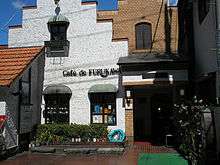 Cafe Furukawa in Ashikaga
Cafe Furukawa in Ashikaga - Cafe Mocha, Ise-cho 3-chome, 9-9 (at the far-end, lefthand corner of the third block of Grand Avenue, which runs north from JR Ashikaga station). F-W (closed Th) 10AM-10PM. Founded in 1974 and run by a father and his two sons who roast their own beans and make their own blends ranging from soft to bitter, Mocha is family-friendly, conversation-friendly, and smoker-friendly. The background music is most likely to be jazz. A cup of coffee costs about ¥450.
- Izakaya Shōhei (居酒屋昌平), Shōhei-cho 2364 (on the righthand side near the start of the flagstone-paved street leading into Bannaji), ☎ +81 284-41-4828. Th-Tu (closed W) 11AM-11PM. Specialty snacks include various udon, donburi, and curry dishes for ¥600-800, horse sashimi (ba-sashi) for ¥1200, and giant umeboshi for ¥100 each. The beer of choice is Sapporo and the cold sake is Akagi, at ¥500-800, depending on size.
- Le Vent Vert, Tōri 3-chome (on the ground floor of the former Ashikaga Bank building that is now a city museum). Founded in 1995 but reopened in the new city museum in 2006. A cup of coffee costs about ¥500.
- Yakitori-kun (やきとり君)), Tōri 2-chome, Nakabashi-dōri (in the middle of the first block north of the Watarase River bridge called Nakabashi; the Tōbu Ashikagashi station complex lies at the opposite end of the bridge). Daily 6-10PM. A well-known hangout for neighborhood regulars throughout the week, and for English teachers and other foreigners on weekends and on Wednesdays when most other small eateries and drinking spots take their regular day off. In warmer weather, tables appear on the sidewalk in front of the small stand.
- Yanagi-ya (柳店)), Eiraku-cho 4-3 (on the right in the first block of Route 293 after it crosses main street running north through the heart of town), ☎ +81 284-41-2724. M-Sa (closed Su) 5:30-9:30PM. This is a combination fresh seafood restaurant, izakaya, and sports bar, especially for fans of the Hanshin Tigers (and sumo). All the sake glasses, even those for Tiger sake, have the names of sumo wrestlers on them. The dishes are well presented and tasty, but there is no English or picture menu. Just ask for the day's specials (osusume) or point to the more reasonably priced items on the wall menu. Snacks range from ¥500 to ¥1200; glasses of Tiger or local sake are ¥500.
- Heart and Roses, Isecho, ichi chome 2-1 ryoumo building 1F (伊勢町1丁目2−1 1F) (From the JR station north exit you can see it; it's the building on the right corner with the Shoya (庄や) on the second floor). M-Sa 9PM-2AM, closed on holidays (except Golden Week). A relaxed, small bar great for having a chat. The atmosphere is rich and warm and the bartender is friendly and speaks English. Prices range such that one can spend as much or as little as they like. Food menu varies depending on availability but is always good. Frequented by the local foreign English speakers on weekends for central location, pleasant atmosphere and lack of table charge. Drinks from ¥500, snacks ¥300-700, meals ¥600-1400.
Sleep
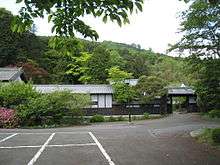
- Gankaen (巖華園), Tsukiya-cho 8-1 (3km north from JR Ashikaga station), ☎ +81 284-41-2338, fax: +81 284-42-9204. Dinner- price above ¥4,410. Sleep- price ¥13,860 per person. You need making reservations and company. A nice, tranquil inn surrounding green hills and a brook. This traditional ryokan has some historical and cultural heritage including Prefectural important cultural properties and National specified tangible cultural properties, and was stayed by many cultured individuals such as Tani Buncho, Watanabe Kazan, Takano Choei, Sakuma Zouzan, Dan Kazuo, Sakaguchi Ango.
- Ashikaga Town Hotel (足利タウンホテル), Tōri 2-2623 (about 10-15 minutes from both railway stations: from JR Ashikaga, turn left onto main street; from Tobu Ashikaga-shi, cross bridge, cross JR tracks, turn left onto main street), ☎ +81 284-21-4114, fax: +81 284-21-4119. Directly across from Chamber of Commerce and city museum, a few blocks from main tourist attractions. Internet access in lobby. Single ¥5145, choice of smoking or nonsmoking. Breakfast included except Mondays.
- Hotel Ashikaga-kan (ホテル足利館), Tōri 2-2658 (5 minutes from JR Ashikaga, turn left onto main street; 10 minutes from Tobu Ashikaga-shi, cross bridge, cross JR tracks, turn right onto main street; the entrance is under an overhead off a parking lot that runs north off main street), ☎ +81 284-44-0111, fax: +81 284-44-0114. On main street, a few blocks from main tourist attractions. Internet access in lobby. Twin ¥4961 per person, single ¥5198. Free parking.
- Hotel Takao (ホテル高雄), Ise-cho 3-8-5 (3 minutes walk from main exit of JR Ashikaga station, 15 minutes walk from Tobu Ashikaga-shi station), ☎ +81 284-42-1121, fax: +81 284-42-1139. A few blocks from the JR station and the main tourist district that encircles Ashikaga Gakkō and Bannaji. Free Internet connection in every room. Western-style single ¥5500, twin ¥10500; Japanese-style double ¥11500. Choice of smoking or nonsmoking. Choice of Western or Japanese breakfast ¥1000, dinner ¥1500.
- Hotel Wakasa (ホテル若桜), Daimon-dori 2374-2 (right across the street from the main entrance to Bannaji Temple, 10 minutes walk from JR Ashikaga station). Internet access in lobby. Per person prices: couple twin ¥3990, business single ¥4350, business wide ¥4980, business deluxe ¥5980. Breakfast included.
- New Miyako Hotel Honkan (ニューミヤコホテル本館), Minami-cho 4254-1 (right at Tobu Ashikaga-shi station on the south bank of the Watarase River; or walk 10-15 minutes from JR Ashikaga station across the river), ☎ +81 284-71-3333. Nice view of river, mountains, and old Ashikaga from 9th floor bar/restaurant. Western-style single ¥7,875, twin ¥15,750; Japanese-style double ¥15,750, triple ¥19,950.
Go next
- Sano
- Tochigi
- Iwafune
- Utsunomiya
- Oyama
- Ota
- Isesaki
- Kiryu
- Tatebayashi
| Routes through Ashikaga |
| Isesaki ← Ota ← | W |
→ Tatebayashi → Kasukabe → into |
| Takasaki ← Maebashi Minami ← Ota-Kiryu ← | W |
→ Sano Tanuma → Tsuga → Moka |